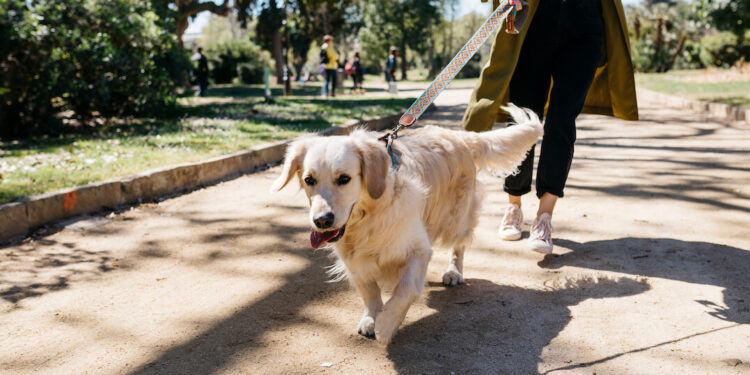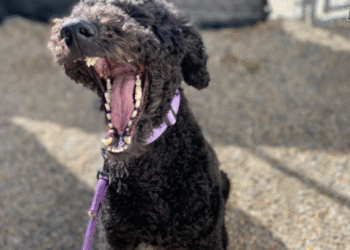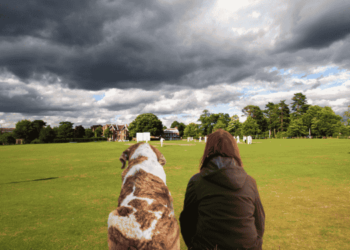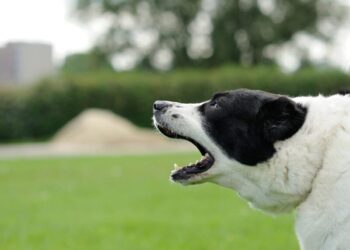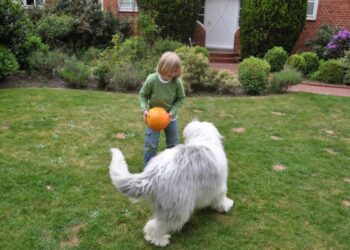Do you have a dog that barks, lunges, or growls at other dogs when you go for walks? Do you feel stressed and embarrassed by your dog’s behavior? Do you wish your dog could be more friendly and relaxed around other dogs?
If you answered yes to any of these questions, then this blog post is for you. In this post, you will learn why it is important to train your dog to ignore other dogs, what are the benefits of having a well-socialized dog, what are the common causes of dog reactivity and aggression, how to assess your dog’s level of reactivity and triggers, and how to use positive reinforcement training to teach your dog to ignore other dogs.
By following the steps and tips in this post, you will be able to help your dog overcome his fear or frustration towards other dogs and enjoy more peaceful and pleasant walks together.
Benefits of Having a Well-Socialized Dog
Socialization is the process of exposing your dog to different people, animals, places, sounds, and situations in a positive and safe way. Socialization helps your dog learn how to behave appropriately and confidently in different environments and scenarios.
Having a well-socialized dog has many benefits, such as:
- Your dog will be more calm and relaxed around other dogs, instead of being anxious or aggressive.
- Your dog will be more friendly and polite towards other dogs, instead of being rude or dominant.
- Your dog will be more adaptable and resilient to changes and challenges, instead of being fearful or stressed.
- Your dog will be more fun and enjoyable to walk with, instead of being a hassle or a liability.
The Basic Principles of Positive Reinforcement Training

Positive reinforcement training is a method of teaching your dog new behaviors by rewarding him for doing what you want and ignoring or redirecting him for doing what you don’t want. Positive reinforcement training is based on the following principles:
- Rewards: Rewards are anything that your dog likes or enjoys, such as treats, toys, praise, or play. Rewards motivate your dog to repeat the behavior that earned him the reward and make him more willing to learn and cooperate with you.
- Timing: Timing is crucial for positive reinforcement training. You need to reward your dog within a few seconds of him performing the desired behavior so that he can make the connection between the behavior and the reward. If you reward your dog too late or too early, he may get confused or frustrated, and not learn the behavior properly.
- Consistency: Consistency is key for positive reinforcement training. You need to reward your dog every time he performs the desired behavior and avoid rewarding him for performing the undesired behavior.
You also need to use the same cues and commands for the same behaviors and follow the same rules and expectations for your dog. If you are inconsistent with your rewards, cues, commands, rules, or expectations, your dog may get confused or frustrated, and not learn the behavior properly.
- Gradual progression: Gradual progression is essential for positive reinforcement training. You need to start with easy and simple tasks for your dog, and gradually increase the difficulty and complexity of the tasks as he improves his skills and confidence.
You also need to adjust the frequency and value of the rewards according to your dog’s progress. If you progress too fast or too slow, your dog may get bored or overwhelmed, and not learn the behavior properly.
The Best Tools and Equipment for Training Your Dog
To train your dog to ignore other dogs effectively, you will need some tools and equipment to help you. Here are some of the best tools and equipment for training your dog:
- A high-quality leash: A leash is a must-have for training your dog to ignore other dogs, as it gives you control over your dog’s movements and prevents him from running away or getting into trouble.
A high-quality leash should be strong, durable, comfortable, and long enough to allow your dog some freedom of movement, but not too long before he can get tangled or distracted. Avoid using retractable leashes, as they can be dangerous and unreliable.
- A well-fitted harness or collar: A harness or collar is another essential tool for training your dog to ignore other dogs, as it attaches to the leash and provides a point of contact between you and your dog.
A well-fitted harness or collar should be snug but not tight, secure but not restrictive, and comfortable but not irritating for your dog. Avoid using choke chains, prong collars, shock collars, or any other aversive devices, as they can cause pain, injury, fear, or aggression in your dog.
- A treat pouch or bag: A treat pouch or bag is a handy tool for training your dog to ignore other dogs, as it allows you to store and access treats easily and quickly. A treat pouch or bag should be spacious enough to hold enough treats for a training session, but not too bulky that it gets in the way. It should also have a secure closure that prevents treats from falling out or getting stolen by your dog.
- High-value treats: Treats are one of the most effective rewards for training your dog to ignore other dogs, as they appeal to your dog’s sense of taste and smell. High-value treats are treats that your dog loves and craves more than anything else, such as cheese, chicken, hot dogs, or liver.
High-value treats should be small enough that your dog can eat them quickly without choking or getting full, but not too small that he can’t see or smell them. They should also be soft enough that they don’t crumble or make a mess.
- A clicker (optional): A clicker is a small device that makes a clicking sound when pressed. A clicker can be used as a secondary reinforcer for training your dog to ignore other dogs, as it marks the exact moment when your dog performs the desired behavior, and signals that a reward is coming.
A clicker can be useful for teaching complex or precise behaviors, or for capturing behaviors that happen spontaneously. However, a clicker is not necessary for training your dog to ignore other dogs, as you can use a verbal marker (such as “yes” or “good”) instead.
A Step-by-Step Guide to Training Your Dog to Ignore Other Dogs

Now that you have learned why it is important to train your dog to ignore other dogs, what are the benefits of having a well-socialized dog, what are the common causes of dog reactivity and aggression, how to assess your dog’s level of reactivity and triggers, how to use positive reinforcement training to teach your dog new behaviors, and what are the best tools and equipment for training your dog, you are ready to start training your dog to ignore other dogs.
Start With Low-Distraction Environments
The first step to training your dog to ignore other dogs is to start with low-distraction environments, such as your home, backyard, or a quiet street. In these environments, your dog will be less likely to encounter other dogs, and more likely to focus on you and your rewards. Practice the following exercises in these environments until your dog can perform them reliably and consistently:
Teach your dog the “look at me” cue
- The “look at me” cue is a command that tells your dog to look at your face and pay attention to you. To teach your dog the “look at me” cue, follow these steps:
- Hold a treat in front of your dog’s nose, and say “Look at me”.
- As soon as your dog looks at your face, click or say “yes”, and give him the treat.
- Repeat this several times, until your dog looks at your face as soon as you say “Look at me”.
- Gradually increase the duration of eye contact, by delaying the click or the “yes” for a few seconds before giving the treat.
- Gradually fade out the treat lure, by holding it behind your back or in your pocket, and rewarding your dog from there.
- Practice the “look at me” cue in different positions, such as standing, sitting, or kneeling, and in different rooms or areas of your home or backyard.
Gradually Increase the Distance and Duration of Exposure to Other Dogs
The second step to train your dog to ignore other dogs is to gradually increase the distance and duration of exposure to other dogs, such as by going to a park, a trail, or a neighborhood with more dogs. In these environments, your dog will be more likely to encounter other dogs but still have enough space and time to avoid direct confrontation.
Practice the following exercises in these environments until your dog can perform them reliably and consistently:
Teach Your Dog the “Watch” Cue
- The “watch” cue is a command that tells your dog to look at another dog briefly and then look back at you. To teach your dog the “watch” cue, follow these steps:
- When you see another dog at a safe distance (such as 50 feet away), point at the other dog with your finger, and say “Watch”.
- As soon as your dog looks at the other dog, click or say “yes”, and give him a treat.
- As soon as he finishes eating the treat, say “Look at me”, and reward him for looking at your face.
- Repeat this several times, until your dog looks at the other dog and then back at you as soon as you say “Watch”.
- Gradually decrease the distance between you and the other dog, by moving closer or waiting for the other dog to approach.
- Gradually increase the duration of looking at the other dog, by delaying the click or the “yes” for a few seconds before giving the treat.
Practice in Different Settings and Situations
The third step to training your dog to ignore other dogs is to practice in different settings and situations, such as by going to a pet store, a dog park, or a busy street.
In these settings and situations, your dog will be more likely to encounter other dogs and face more challenges and distractions. Practice the following exercises in these settings and situations until your dog can perform them reliably and consistently:
Teach your dog the “leave it” cue
- The “leave it” cue is a command that tells your dog to ignore something that he wants or is interested in. To teach your dog the “leave it” cue, follow these steps:
- Hold a treat in your closed fist, and present it to your dog.
- As soon as your dog sniffs or licks your fist, say “Leave it”.
- As soon as your dog stops trying to get the treat and looks away from your fist, click or say “yes”, and give him a treat from your other hand.
- Repeat this several times, until your dog stops trying to get the treat and looks away from your fist as soon as you say “Leave it”.
- Gradually increase the difficulty of the task, by opening your fist slightly, placing the treat on the floor, or moving the treat closer to your dog.
- Practice the “leave it” cue with different objects, such as toys, food, or trash.
Use Treats and Praise to Reward Calm Behavior
Another exercise to train your dog to ignore other dogs is to use treats and praise to reward calm behavior. To do this, follow these steps:
1) Whenever your dog is calm and relaxed in the presence of another dog (even if the other dog is close by or moving), click or say “yes”, and give him a treat and praise.
2) If your dog starts to react towards the other dog (by barking, lunging, or growling), ignore or redirect him by walking away or asking him to perform a different behavior (such as sit, down, or touch).
3) Repeat this every time you see another dog until your dog learns that being calm and ignoring other dogs earns him rewards while reacting toward other dogs earns him nothing.
Avoid Punishing or Scolding Your Dog for Reacting
- The fourth and final step to training your dog to ignore other dogs is to avoid punishing or scolding your dog for reacting.
Punishing or scolding your dog for reacting will not teach him how to behave differently, but will only make him more fearful or angry towards other dogs. Punishing or scolding your dog for reacting will also damage your relationship with him, and make him less likely to trust you or listen to you.
Instead of punishing or scolding your dog for reacting, follow these steps:
- Stay calm and composed: If your dog reacts towards another dog, do not panic or lose your temper. Stay calm and composed, and breathe deeply. Your dog can sense your emotions and energy and will mirror them. If you are calm and composed, your dog will be more likely to calm down and follow your lead.
- Move away from the situation: If your dog reacts towards another dog, do not force him to stay in the situation. Move away from the situation as quickly and safely as possible. This will help reduce the stress and tension for both you and your dog, and prevent further escalation or confrontation.
- Analyze what went wrong: If your dog reacts towards another dog, do not blame yourself or your dog. Analyze what went wrong, and learn from it. Identify what triggered your dog’s reaction, such as the distance, duration, intensity, or type of the other dog. Identify what you could have done differently, such as using a different cue, command, reward, tool, or technique. Identify what you can do better next time, such as choosing a different setting, situation, time of day, or weather condition.
Well, That’s a Wrap
By following the steps and tips in this article, you can help your dog become more calm, confident, and well-behaved around other dogs, and have more fun and less stress on your walks together.
Remember to be patient, consistent, positive, and flexible with your dog, and to reward him for his progress and achievements. If you have any questions or comments, please feel free to leave them below. We would love to hear from you and your dog.


